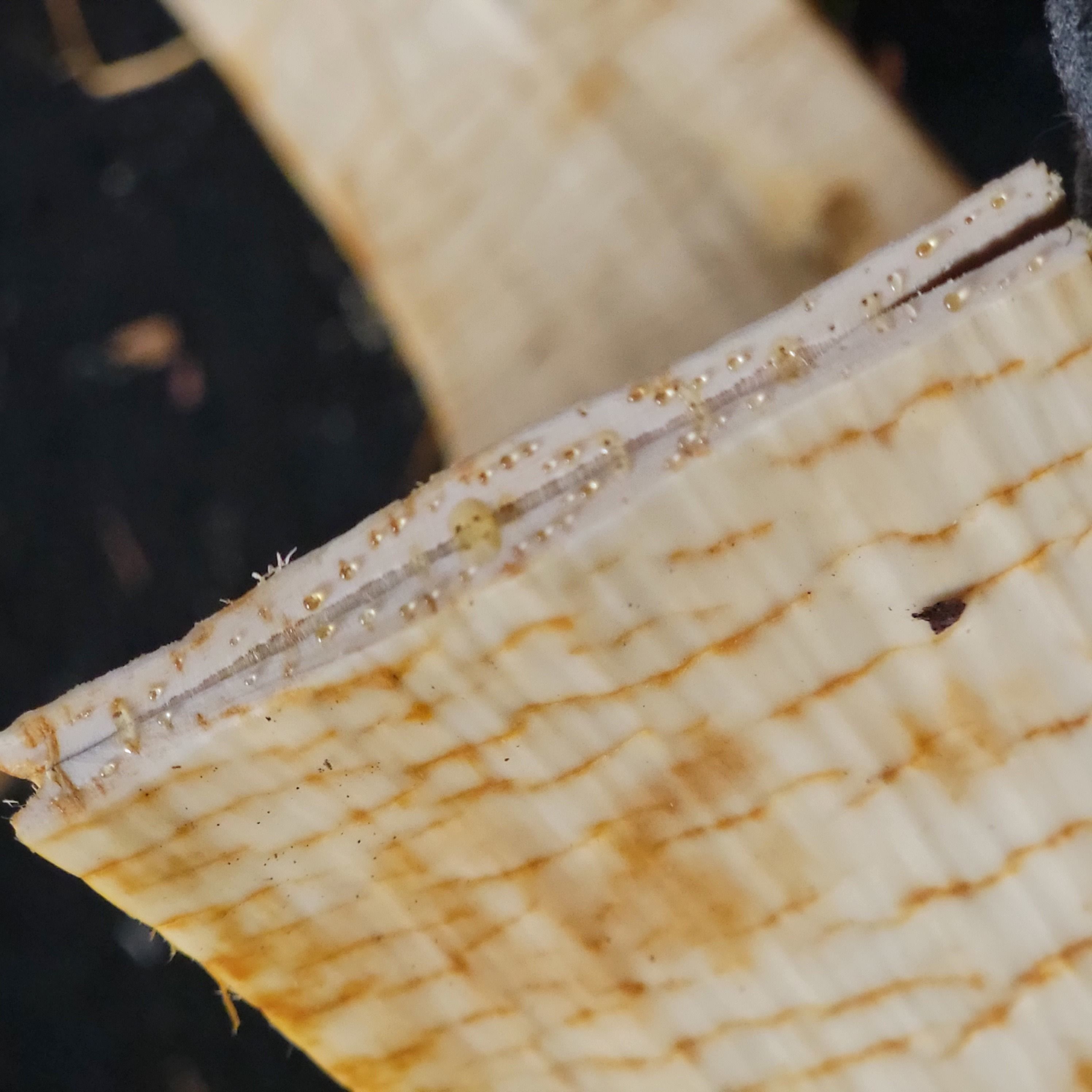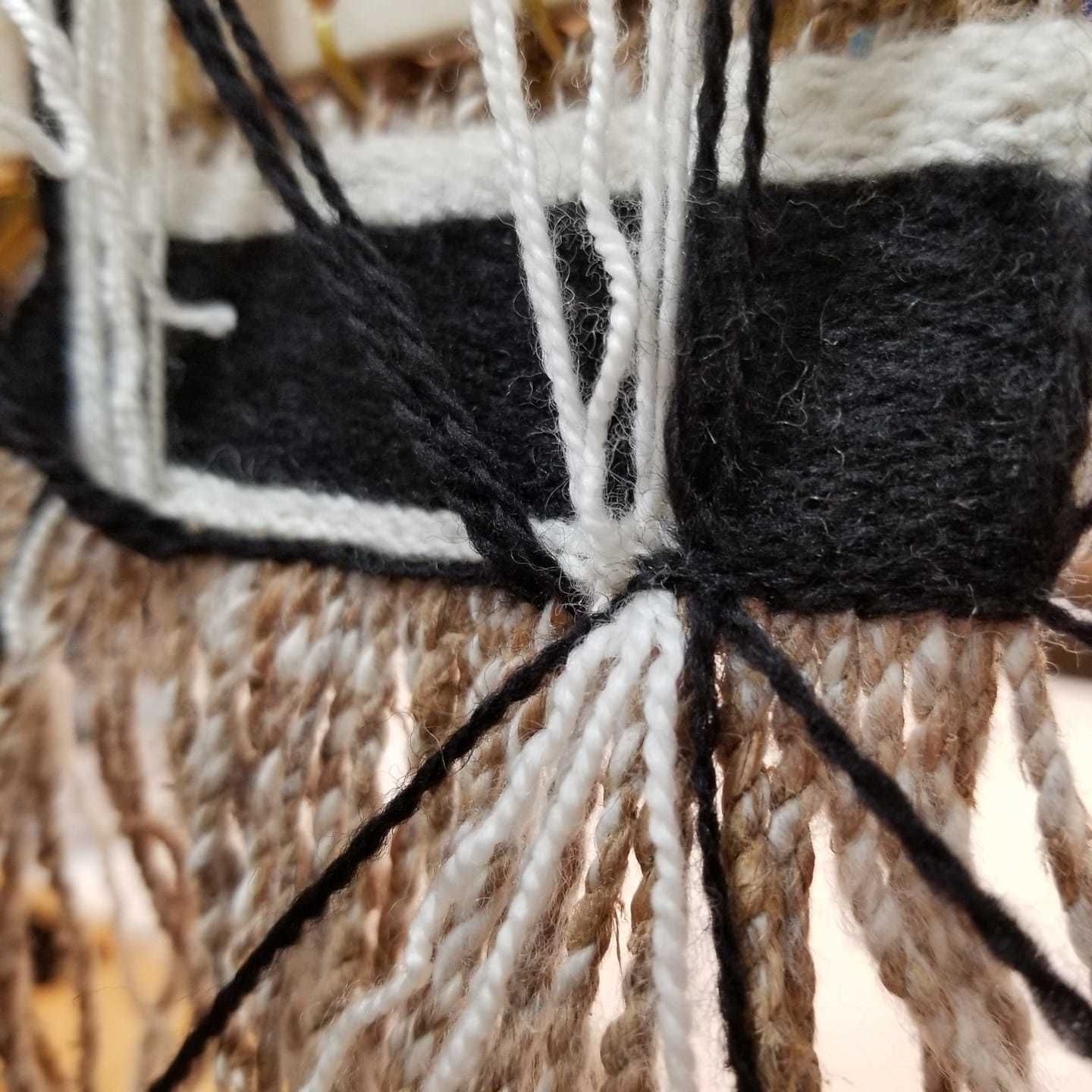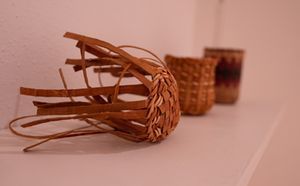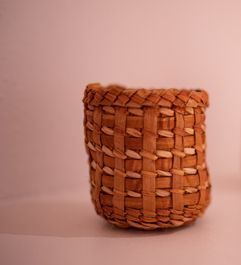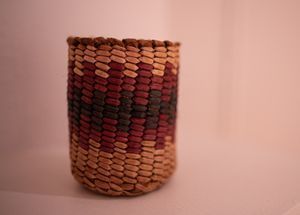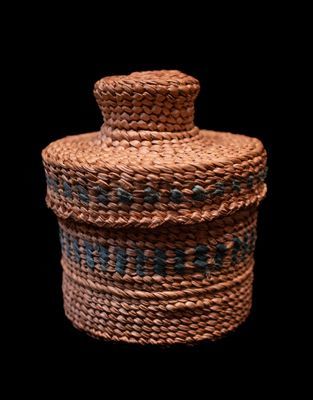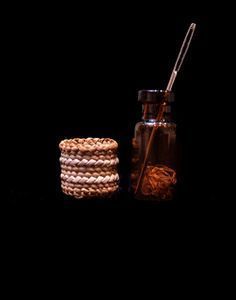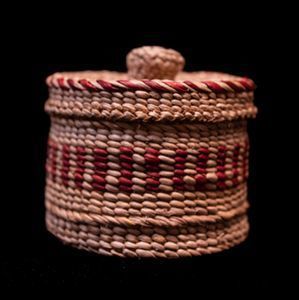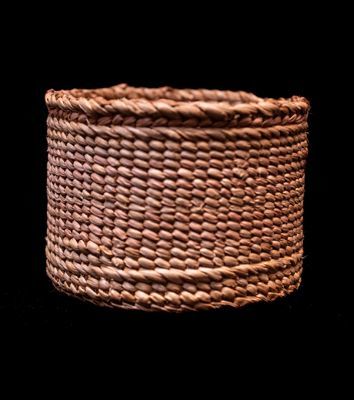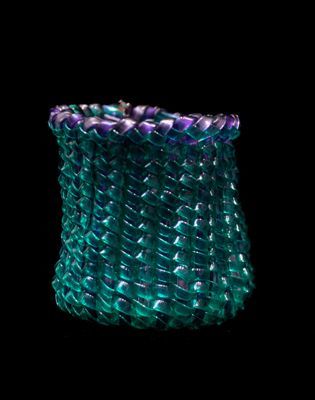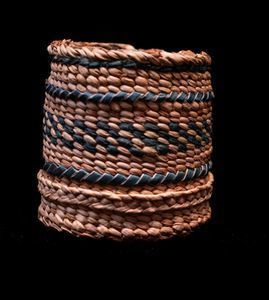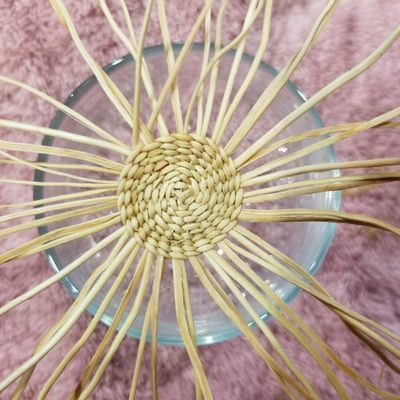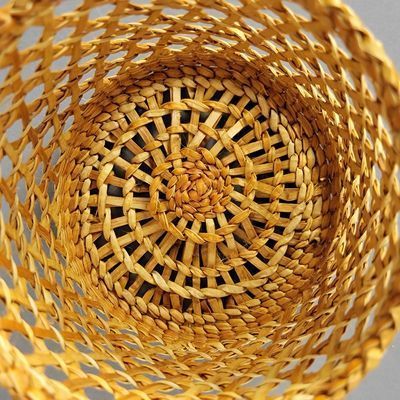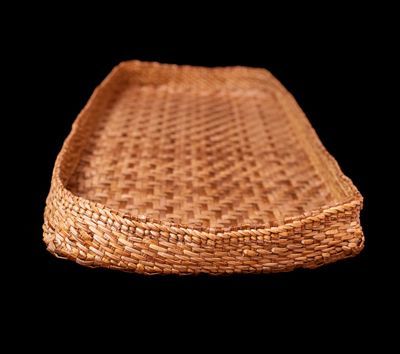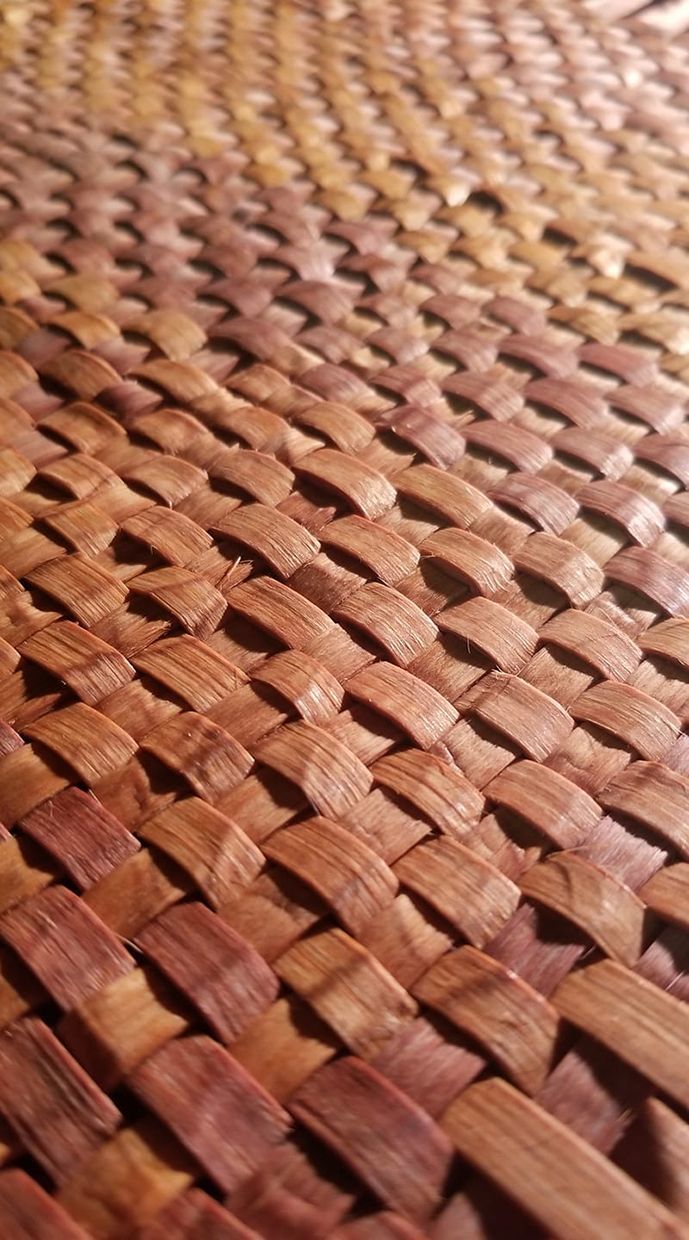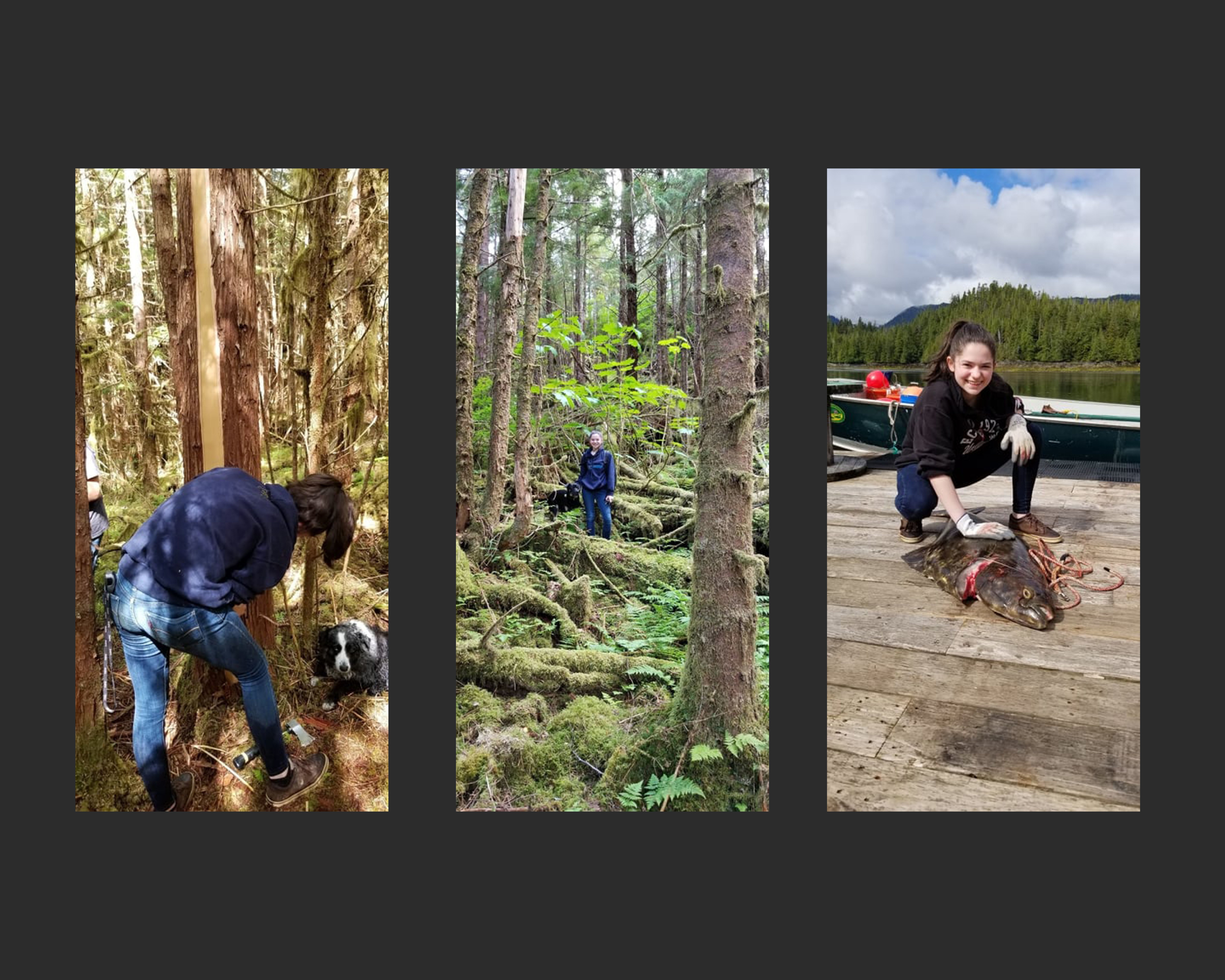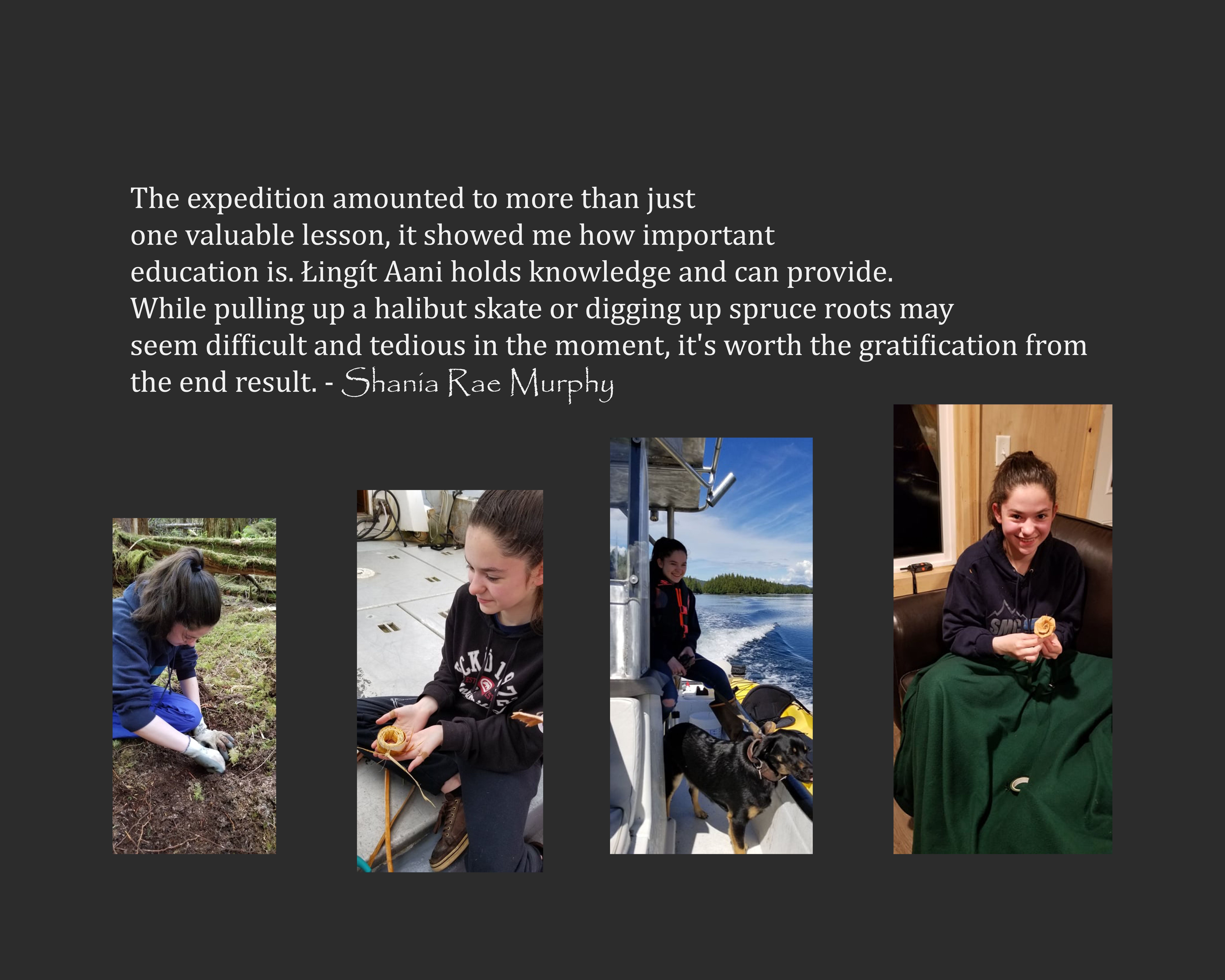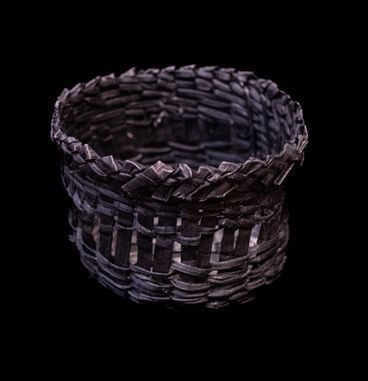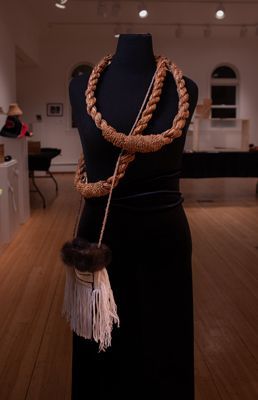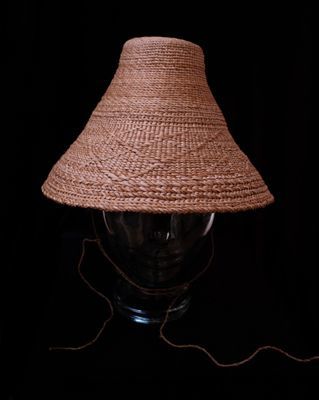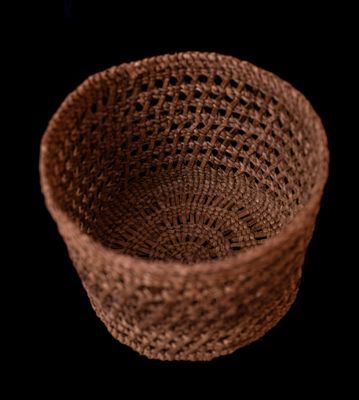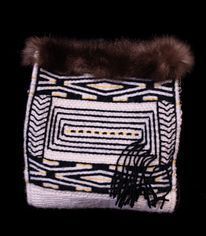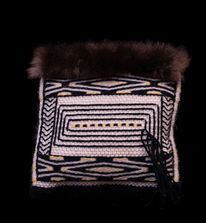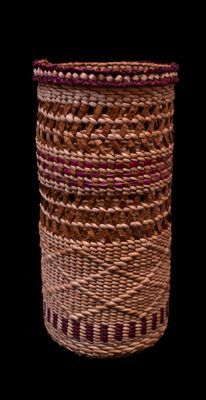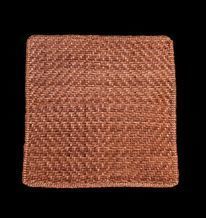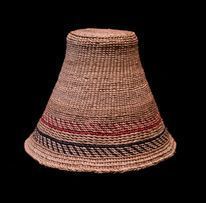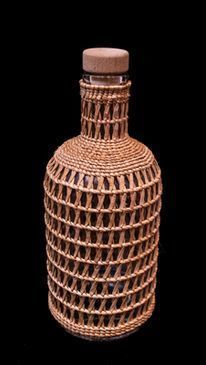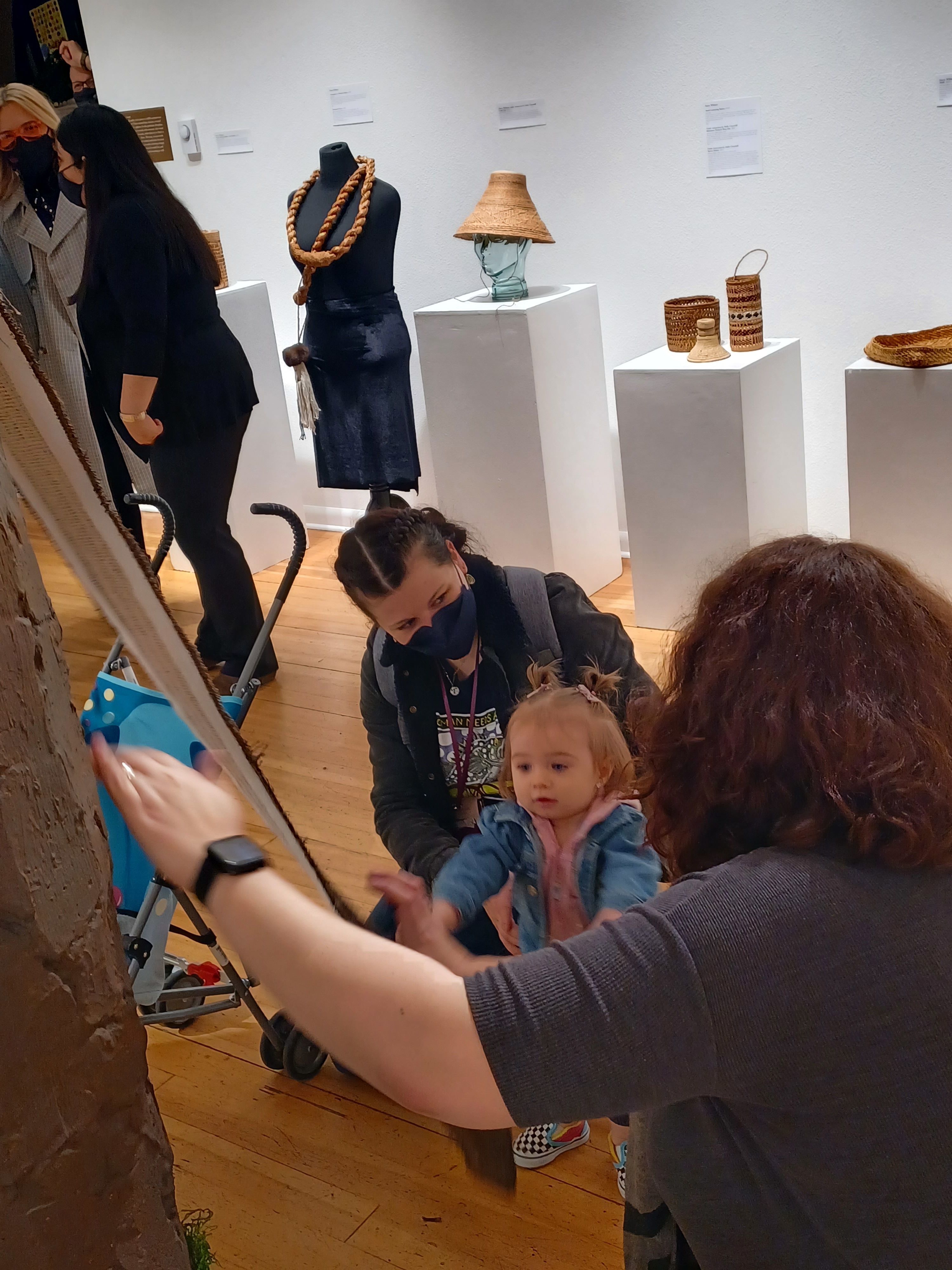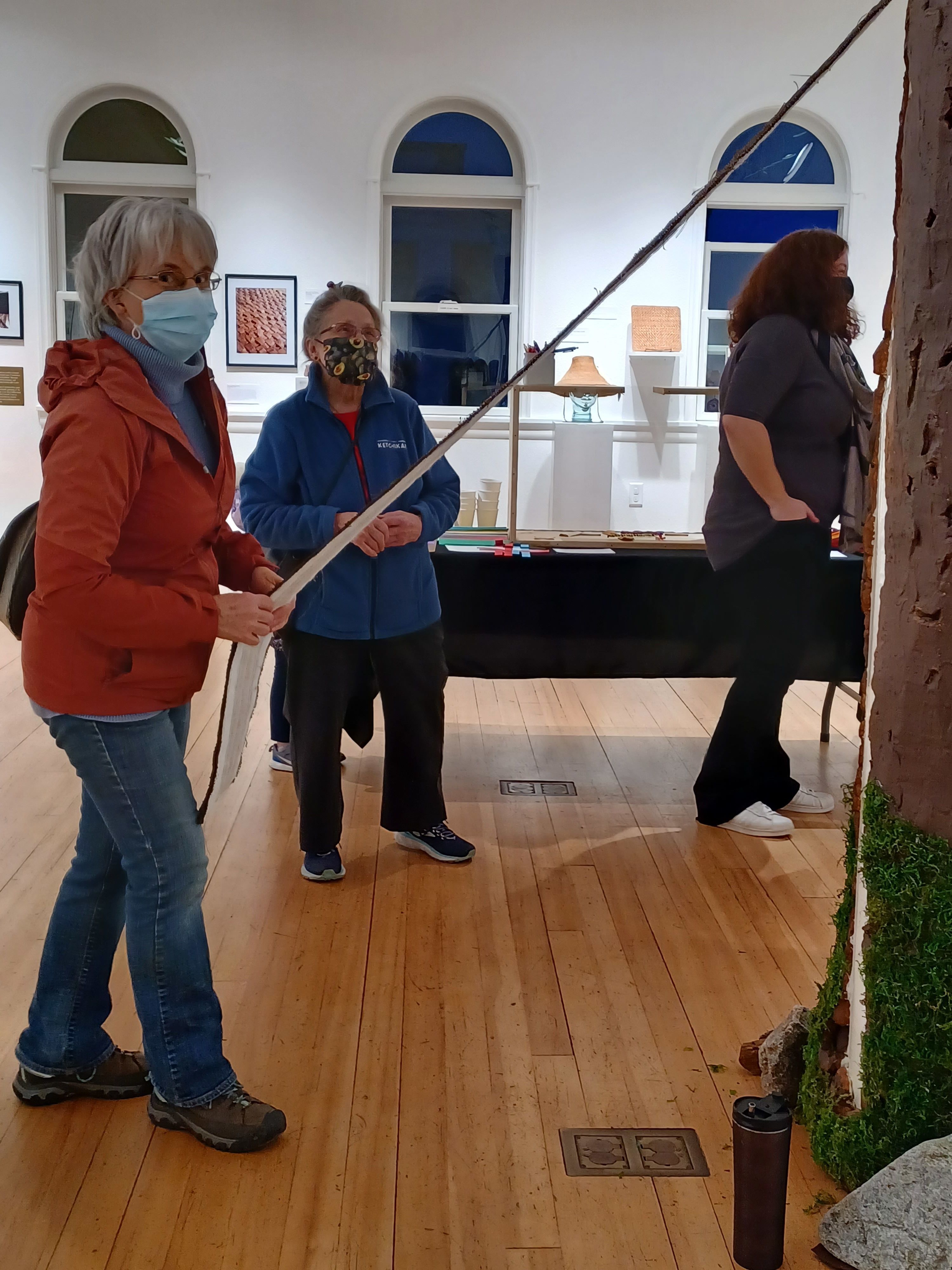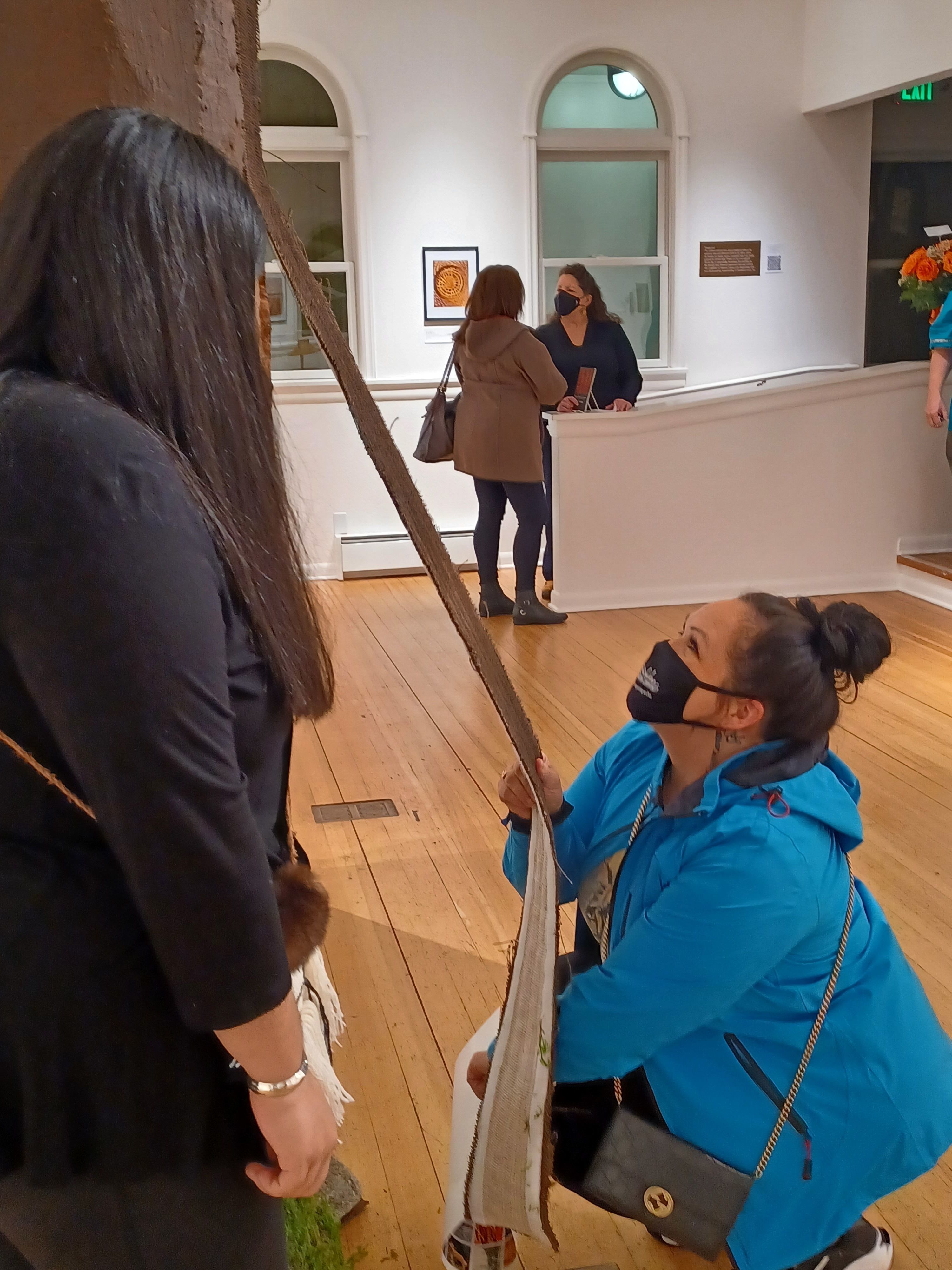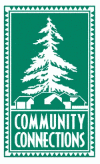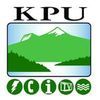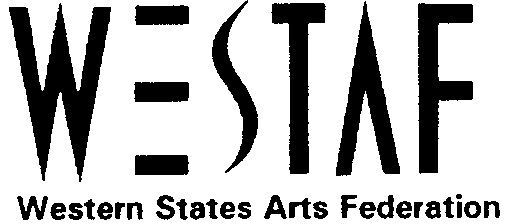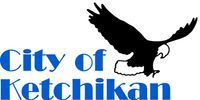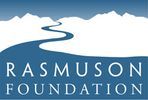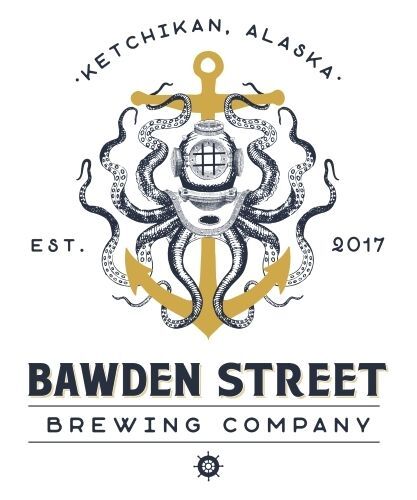"Learning Through Teaching" by artist Stacey Williams
An educational and interactive exhibit encouraging all ages to learn about the Alaska Native weaving practices of the Southeast.
Stacey has compiled an exhibit that will take you through a journey of her self-discovery. She has written the words below with the intention of defining herself as a student and a teacher. She acknowledges her mentors, teachers, and students, and she recognizes the role they all play together as culture bearers. Stacey invites everyone; people of all ages to embrace their role as students and teachers.

Stacey Williams
This exhibit is brought to you by nine years of learning, seven years of teaching, countless hours of practice, and a wish to bring more people to the love of Northwest Coast Art. Though I am nowhere near being a master at these art forms, it is a responsibility undertaken at the moment of learning to make sure to teach it to others. My teachers have told me stories of when they were still learning, at a time when you could count the number of woven hats at Celebration in Juneau, Alaska. Thankfully, those times when they were learning were followed by periods of teaching and a revival of the art forms. Now, we look to these teachers to continue their lessons, reshape the classroom norms, and train the next group of teachers.
Throughout my years I have been surrounded by wondrous art forms, a revival of culture, and important individuals who have impressed upon me the importance of the continuance of Our Way of Life. I call this collection "Learning Through Teaching". It is an exhibit that explains my own experiences having learned the displayed art forms while teaching them to others.
As the artist, I would like to gratefully acknowledge that this exhibit is made possible through the generous stewardship of this land by the Saanyaa Ḵwáan and Taantʼa Ḵwáan people. Since time immemorial this area has been looked over by the strong people of these tribes and I am grateful for their efforts. Welcome! -Stacey Williams
Learning Through Teaching
To me, this means that I am fulfilling a responsibility to my fellow artists, to my students, and to those who wove before me. As I learn different skills and techniques, I teach them to others in order to reinforce the lesson. This raises questions from students that then cause me to rethink how to explain it, and even consider a different way to learn it. I learn as I teach, or rather, through the teaching, I am able to learn.
Classroom Kit
Displayed are strips of red and yellow cedar to begin a basket, the strips in place that a student would plait and then twine, a basket bottom ready to weave up the side, and two completed projects. This is typical of what the process looks like for beginner students at an elementary level, and for adults interested in knowing if this craft is something they would consider pursuing further. The piece made by an adult was completed in an afternoon class by Gara Williams, with all material prepared to start.

This is a collection of plaques that my father has kept for many years. He, my siblings, and I are all proud graduates of Ketchikan High School, where we all did our first carvings under the guidance of the Native Arts instructor, Barbara Pierce. She taught my siblings and me the fundamentals of Northwest Coast Design throughout our years at Kayhi. I have used these lessons for many years and also share them with my students and peers. Fundamentals of design are the most important lessons to master.

red and yellow cedar plaques dating from 1980s - 2016
Teachers
I have had the honor and privilege of learning under many different educators, in a range of specialties. I’d love to name them all, but there are a few that deserve special recognition. In order of appearance in my life, here are a few ways that teachers and educators have had an impact.
In 4th grade, I had a classroom teacher who was dedicated to her students having a well-rounded learning experience. This included, and was not limited to, having culture bearers come into the classroom to teach their own lessons. I remember learning about summer fish camps, traditional songs, and essential cultural values. This teacher is now a dedicated reading specialist and has the title of Dr. Valerie Brooks. Val, thank you for your impact. I know you understand the significance of teaching our youth.
When I moved into Ketchikan High School, I met Barbara Pierce. She taught me valuable and fundamental lessons about Northwest Coast Art, including leather sewing, carving, design, and beadwork. I jokingly say that I wasn’t in her roster every year, but it felt like I was always around her class. Other teachers took note of my passion for the arts and allowed me to work simultaneously on art and the work of their classes where appropriate. Doing beadwork gave me the focus to listen to lectures.
Later on, in high school I registered for a spring break weaving class for youth at the Totem Heritage Center taught by Holly Churchill-Burns. There I found an aptitude for weaving. I didn’t know it at the time, but I would return to the museum several years later to continue my learning. I worked at the museum as a program assistant starting in 2014 and ending in 2020, spending a lot of time with Holly. She would share essential lessons with me and others, and the moments spent in her classes have been a precious source of knowledge. I am honored to consider myself one of her students.
While at the Totem Heritage Center, I met many instructors. All were dedicated to sharing the arts in a thoughtful and passionate way. One whose passion cannot be disputed is Diane Douglas-Willard. She shared secrets she had discovered, encouraged every move I made as a student of weaving and was a beacon of hope for the arts to continue on to every student she met. The detail and attention she had for every piece was astounding.
Another culture bearer that I have had a wonderful time learning from is Gloria Burns. She was my first harvesting instructor and has been a supportive friend for many years. Her diligent work on language, harvesting techniques, and her adoration for her culture has been inspirational throughout my own journey. I hope to continue learning from her in any capacity she is willing to teach, but most especially in the fields of weaving.
Teresa Varnell is one of the most dedicated educators I have had the pleasure of working with. I first met her while at the Totem Heritage Center giving classroom tours. Her passion for educating students is unparalleled and inspiring. In recent years, we have collaborated on lessons for youth through her current position as cultural coordinator for Ketchikan Gateway Borough School District. It is important to teach what is learned so that the next generations can learn about the cultures of Southeast Alaska, and Teresa is an enthusiastic teacher as well as a supportive mentor in this journey.
The traditional Alaska Native Northwest Coast Arts will survive and thrive. In my case, I will continue to teach and to learn thanks to the teachers set in my path and the encouragement from everyone who surrounds me.
Yakutat
In the spring of 2019, I went on a trip with my master mentor Holly Churchill. As her apprentice, I was to participate in a number of activities, go harvesting with intention, split roots until my eyes were crossed, and then towards the end teach what I had learned. It was one of the most enlightening and inspiring trips I’ve been on.
We rose in the early morning, ate a light breakfast, and went to the forest. It took a while to drive, and longer to find just the right spot. Before 8 a.m. we found a grove of spruce trees and got right to work. Carefully peeling back the moss-covered layer of dirt we exposed the most wonderful roots. Digging in silence for quite some time, listening only to our own rhythmic breathing along with the crash of the waves on the beach, we gathered enough roots to provide for the children’s program. Later that week, we had a group of youthful weavers who had participated in the festivities of the Yakutat Tern Festival. They were eager to learn where the materials came from. Holly pointed to me to teach what I had learned just a few days earlier. I was confident in my teacher, which leads to confidence in oneself. I knew she would not lead me astray, and so with all honesty of being a student myself, I carefully and swiftly delivered instructions to the class. Very quickly these elementary students got to work, and were following root paths more than fifteen feet long! The pride felt by a teacher is summed up in those learning moments. When the student surpasses the teacher, they both have done valiant work.
Learning through teaching is the most essential element of the continuation of the art form.
My Students
Houghtaling Elementary
I have spent more time at Houghtaling Elementary throughout my years than any other school on the island. It was such an honor and privilege to return to my former school and learn with the next generation of students. My first return was to a 4th grade classroom. We did a rope-making activity with red cedar bark. The students in that class learned about oxidizing cedar with metal, how to spin the material into rope, and a bit about how it is processed. Later that evening, I went to an opening at the Main Street Gallery. One of the students was present, looking curiously at one of the pieces hanging on the wall.
I asked him, “Do you know what that is?”
He replied, “Is that cedar rope? Like what we learned today?”
After I confirmed that yes, he knows how to do that too, the smile on his face could not be contained. He ran to his mom, tugging on her sleeve to say “Guess what! I learned how to do that today!” This is why we do it. This is why we teach. No matter how big, no matter how small, this is why we teach-- so that those connections can be made.
Shania Ray Murphy
At the end of the school year a few years ago, a group of students was led out to the wilderness to learn about the area, the culture, and subsistence opportunities. I was a chaperone/cultural bearer for the annual Tribal Scholars Expedition.
One particular student decided it was time to go above and beyond on this journey. This student participated in tasks of such variety! From manning the shrimp boat to fishing for halibut, going kayaking, hiking, gathering spruce roots, and harvesting bark, there was nothing that would slow this student down. Instead of being instructed to do these activities, she volunteered time and time again. While they were learning about roots, I got to know this student and the struggles she is faced with on a daily basis. Despite physical disabilities, she showed up.
Preparing roots is hard work. Those dedicated to the craft know that if you aren’t careful with your time you can end up with cramped hands, bloodied fingers, and perhaps even ruining a near-priceless project. Preparing cedar bark is hard work. It should not be done on a whim. There are those that feel a connection to the forest and understand the gravity of the situation when you harvest the bark. The work does not end there. After harvest, you immediately have to process. This can take several hours or all evening. All this, before you can use what was prepared and make something amazing
I’d like to take a moment to acknowledge that this student, Shania Rae Murphy, listened intently to my words of caution about harvesting and weaving. She heard what I had to say and decided for herself that this was something she at the very least had to try.
Commissions
I have made quite a few pieces to fulfill commissions. Over the years I have created hats, baskets, covered items, even a few pillows. In this particular discipline, it is more effective to work with someone who wants the piece before it is made, rather than try to find it a happy home after it's done. This way, you can work out any changes that are wished and make the piece that is wanted. Truly, what works is having a happy home for baskets and pieces to be cared for, and room for artists to make what is inspiring as well.
Peers and Support
First, Josephine Guthrie, a weaver whose passion is unrivaled. She has been a dedicated student under Holly Churchill, Delores Churchill, Evelyn Vanderhoop, Dorica Jackson, Diane Douglass Willard, Kathryn Rousso, Debbie McLavey, her mother Irene and a few master carvers. She has proven herself to be an avid learner. I have watched her grow, from clumsy fingers to a swift and graceful weaver. I look forward to seeing what she does with her art
Next, Justin Cristobal, a designer and carver that has studied under Nathan Jackson, Steve Brown, David Robert Boxley, and many others. I have been impressed and in awe of his process for many years and asked him to submit a piece to this exhibit that represented our time as students together. He says, “My teachers taught me the fundamentals in Formline, but now my teachers are artifacts, using what I learned to figure out how they put together designs using those fundamentals.”
Last but certainly not least, Mangyepsa Gyipaayg - Kandi McGilton, Ts’msyen artist. She is a self-taught beader, a student under Delores and Holly Churchill, and an enthusiastic language pupil. Through regular messages, photos back and forth, 3 a.m. questions, and all the encouragement that can fit between two artists, we have achieved a level of support for one another that shows our dedication. Whether I am working on something for a private collection, or something to be displayed publicly, this artist is my go-to for an honest and supportive conversation.

Stacey Williams
Chilkat Sample, 2019
Merino wool, boiled yellow cedar
This sample was made as part of a class at the Totem Heritage Center. Dorica Jackson taught a group of students including myself using this design. She was very patient while demonstrating the finer points of the fundamentals. I learned about turning corners, weaving braids, and using joints.
41/2” X 6” with 2” fringe
NFS
Current Mentor
Dorica Jackson is an incredible and supportive friend, as well as a mentor. I have been studying Chilkat weaving with her for several years. I watched as she wove together a beautiful robe, now displayed at Ketchikan Museums Totem Heritage Center. I carefully observed her swift movements and examined each section with the intention that one day I will be able to also create finer pieces. We started small, with learning how to spin the warp of boiled yellow cedar, and finally gathering the wool and the carding of debris. The piece is my first Chilkat item, and I was able to spin all of the twenty-five yards for it myself. I was so proud to take it off the loom, and even more, honored that my mentor believed I could. Dorica, thank you for your support and confidence in me. I hope to continue learning with you for a long time.
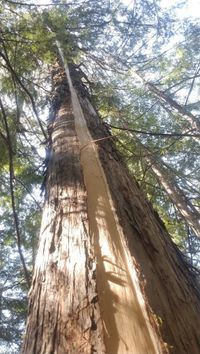
60 ' yellow cedar tree, recently harvested.
The Trees of the Tongass National Rainforest
The trees in the forest are highly respected by the indigenous peoples of this area. The western red and yellow cedars along with spruce, hemlock, and alder trees are a treasured resource. They are carefully harvested in order to gain weaving material, rope material, and natural dyes. To this day, the traditions of harvesting bark remain and have guided weavers since time immemorial. The weaving techniques that provide means to gather food (rope), store food and cook food (baskets), and cover yourself in garments were essential to the continuation of life on the Northwest Coast.
The Tree of Life
Harvesting from The Tree of Life the western red cedar is a special kind of responsibility. There are too many people who know the steps of harvesting but have little understanding of the deep impact that harvesting has. I was taught by generational weavers that a harvester should walk as deep into the forest as they are able, away from trails where those enjoying nature would see. We walk as far as we can so that those less able to walk that far can harvest closer to road and trail. Only elders and those with limited means of mobility have the right to harvest in more accessible areas. People usually have support from others to get back further into the forest.
To assess a tree you think is ready for harvesting, think about where it is. Think about which side the branches lay in the sunlight. Give it a hug to see if it’s the right age. A huggable tree should have the right amount of sap and grain lines. Give thanks for the tree being there and take the outer bark off next to the tree. Don’t take more than you can process in one day; one tree can be up to eight hours of stripping and processing. There is also a limit to how much any tree can give; if you overharvest the tree, it will not be able to heal itself.
Interactive Display
The red cedar tree in the exhibit was created and constructed by Stacey and Gara Williams to practice a pull. Before that can happen, please pay attention to these “Guidelines of Harvesting”
- Respect yourself, respect others, and respect the environment you are in.
- Center yourself. Clear your mind of other thoughts, wants, wishes, and start at peace.
- Think about why you are doing this.
- Only do it once; to do it repeatedly would represent taking more than what is needed from a tree.
- Start at the base of the Tree of Life. Peel back enough to get a grip.
- Slowly pull towards the ground and away from the base. DO NOT try to rip it hard or at an upwards angle.

Why a Tree?
The first time I presented this exercise was in a classroom at Houghtaling Elementary. The idea was to engage in an activity that represented harvesting, without taking a whole group far out into the forest. I ran some painter's tape down the middle of a doorframe and the goal was to peel it at a downward angle without tearing it in half. The students were excited to participate and ended up being pretty talented at it. They were also very encouraging to each other, giving helpful hints and watching out for the tear of the tape. This is a prime example of Learning Through Teaching; I wouldn’t have known it would work until I tried it out with a classroom of students. I tried it again the following week with a different class and had spectacular results there, too. The idea of a life-sized tree trunk for others to be able to pretend to take a strip was born. In this version, strong and thick cardboard tubing was used for a base layer. Two tubes had to be mounted together with spray foam covering the full area of the “tree.” The foam was shaved down, and silicone was spread to seal the foam's many holes. Epoxy resin was poured along the crease of the pulling area. A “cedar strip” was created out of fabric, with a darker side for the outer bark and a lighter color for the inner bark. This was attached to the tree under the spray foam and strips of Velcro were added.
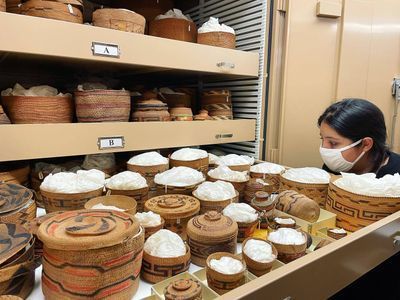
photograph of Sheldon Jackson Basketry Collection, 2021
11” X 14”, framed
Research
It is essential that as we undertake traditional art forms we engage in research as well. Some research must be done by examining items held in museum collections. These arts were almost lost, and have been reclaimed by the current generations. During my time at the Sheldon Jackson Museum in Sitka, Alaska as an Artist-in-Residence, I was constantly learning new things and sharing them with the staff, visitors and friends far away. Pictured is a photo of my amazement when viewing just one of the many drawers full of baskets. I was also able to study two Chilkat blankets, a Chilkat tunic, smaller woven spruce root items, and various utilitarian items from several Alaska Native cultures. Sitka, Alaska is such a wonderful place, and the people there were so happy to learn with me and share that learning with someone else.
Learn More
Stacey has put together some interactive videos on her website StaceyWilliams Weaver to share techniques that can be practiced at home. Supplies are available for free at the Main Street Gallery through March 25th or you can use supplies from home. Check out these wonderful interactive videos HERE!
Click on the image for artist narrative and link to purchase



